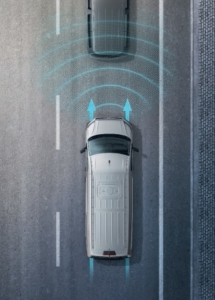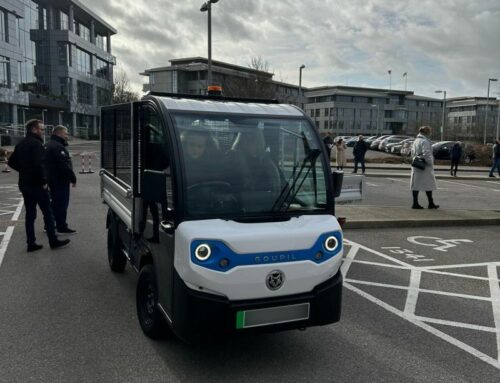Autonomous emergency braking
- VW first van manufacturer to fit AEB as standard
- Cited as ‘most significant development in vehicle safety since the seat belt’
- Potential to save 100 lives and 120,000 casualties over next decade
- Shown to cut rear-end crashes by nearly 40 per cent
- Potential to save lives, cut accidents and costs of insurance, repairs and downtime
VOLKSWAGEN is being hailed as a safety trailblazer as the first commercial vehicle brand to fit all its vans with autonomous emergency braking (AEB) systems.
All customers ordering a new Caddy, Transporter or Crafter van from 1 June will be guaranteed extra safety as standard with the Front Assist with City Emergency Braking – a system already standard on some new car models.
According to Thatcham Research, the motor insurers’ automotive research centre and respected experts in safety, security and crash repair, autonomous emergency braking (AEB) systems are ‘probably the most significant development in vehicle safety since the seat belt’ and have the potential to save more than 100 lives and 120,000 casualties over the next ten years.
AEB has been mandatory on all new big trucks since November 2015 and is fast being fitted on new cars to meet raised Euro Ncap crash safety standards.
Not only does autonomous emergency braking have the potential to reduce the number and severity of accidents, it has also been proven to cut third party injury insurance claims by 45 per cent.
For van drivers and fleet operators, this means lower costs as well as less downtime thanks to fewer crashes and therefore drivers and vans kept on the road – and working – for longer.
In addition, vehicles fitted with autonomous braking systems have an average insurance premium reduction of ten per cent compared to those which don’t.
Commenting on the development, VW head of marketing Sarah Cox said: ‘Producing safe, reliable vans has been at the heart of our brand for over 60 years. But technology is advancing at a pace and we’re continually seeing more and better ways to keep drivers safe on the road.
‘We’re really proud to be the first to fit AEB as standard to all our vans. This means safer vehicles on our roads, leading to fewer accidents, lower costs for operators and potentially fewer lives lost: what could be more important?’
Peter Shaw, chief executive at Thatcham Research, said: “Volkswagen is a trailblazer and should be applauded for being the first manufacturer to fit AEB as standard on all its vans in the UK.
“The truth is that we are seeing a year on year rise in deaths and serious injuries involving vans which this technology can help to avoid.
“It is shocking that AEB, a proven lifesaving technology, has not been widely available to van owners or drivers until now. We call upon all vehicle manufacturers to follow Volkswagen’s lead, and fit AEB as standard across all their light commercial vehicles as soon as possible.”
How autonomous emergency braking works
Using a radar built into the front of the van, Front Assist recognises critical distances to the vehicle in front and helps to ensure safe stopping.
In any dangerous situations Front Assist reacts here in two stages: first the assistance system warns the driver with audible and visual signals of any vehicle in front driving slowly or suddenly braking and of the associated risk of collision. In parallel it gets the vehicle ready for emergency braking – by applying the brake pads and alerting the brake assistant.
If the driver fails to react to the warning, a one-off short jolt of the brake indicates in the second stage the looming danger of a collision and the brake assistant’s responsiveness is further increased.
If the driver then hits the brakes, full braking power is immediately available. If the driver does not brake strongly enough, Front Assist increases the braking pressure to the required level, so that the vehicle comes to a stop before reaching the obstacle.
The system also includes the City Emergency Braking function, which provides assistance at low speeds of under 18mph.
If the driver fails to see or react to an obstacle, the system automatically applies the brakes and ensures that the speed of any collision is reduced. Ideally, it completely prevents the vehicle from running into the obstacle.
Three-quarters of collisions occur in so-called city environments (at under 25mph) and a 2015 study by Euro NCAP and Australasian NCAP showed autonomous braking leads to a 38 per cent reduction in real-world rear-end crashes.








Leave A Comment